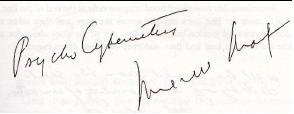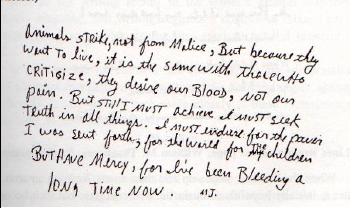
|
We
have Trained Handwriting Experts in Over 17 Countries Worldwide
through
our home study courses. |
|
Are You Depressed? Written by Guest Author, Mark Dehe A person's mood can often be determined through a variety of means. If they are happy, they have a pronounced spring in their step and their face has a certain 'glow' about it. On the other hand, if that person is depressed, their shoulders sag, their feet drag; in general, they just do not stand as tall as they would, were they happy or just feeling normal. The same impressions can be determined by listening to
a person's voice. How many times have you received a sales call and the
salesperson was clearly bored with their job or reading the conversation
from a script, and you knew this because you could The same can be ascertained from a person's handwriting. Sometimes, when they're happy, it's obvious, sometimes it's a little more discreet. Equally obvious are signs of the opposite trait - depression. In this article, I'll show you briefly how to spot optimism in a person's handwriting, how to watch for signs of depression, and I'll explain why determining depression can be extremely important. Optimism is the ability to see the best in all
situations. If bad things happen to an optimistic Optimism is revealed in a person's handwriting two separate ways. The first is displayed in the crossbar of the letter 't'. If the crossbar travels in an upward position from left to right, meaning it ends higher than where it started, then optimism is present. This is the more common occurrence. The second is displayed in the overall appearance of
the handwriting itself. If the overall handwriting goes in an upward
slant, again, optimism is present. There is no benefit to using one
optimistic trait or the other. Writing with an upward slanted
baseline
An important point to keep in mind, is that if the person does not possess the optimistic trait, it doesn't automatically mean that that person is depressed, nor does it mean that he or she is not optimistic. This simply means that the person that does possess this trait is generally more optimistic than those without it, as it is a core part of who they are. On the flip side of the coin, just as optimism is always considered positive, depression is always considered a negative trait. There are various forms of depression that are represented in a variety of ways. For the sake and space of this article, however, I'll devote my attention to the sole task of identifying depression itself. When locating depression in a person's handwriting, it
is important to ask, "Is this person clinically depressed or simply
going through a temporary case of the blues?" - something everybody
goes through from time to time. Answering that question Depression, generally speaking, is a temporary emotion.
When the situation that is causing the depression has passed, the
person's handwriting should revert to normal (or at least normal for that
person.) Long term depression that has worked its way into a person's
subconscious and has now become the norm for that person, is more
permanent
The overall look of the handwriting is slanted at a
downward angle. It may begin normally, resting on top of the line, but,
as the words make their way across the page they go little by little
below the line. If written on unlined paper, the overall look will still
be the same. If you were to hold a ruler across the page, the end of each
or most of the sentences Again, there are a wide variety of choices in the depression arena. For example, it is possible for each word to start normally but end slightly lower than it began, with the next word starting in the normal 'starting' position and ending lower, only to continue the trend throughout the text. Some handwriting samples may have an overall concave appearance or convex appearance. Again, each has a different meaning. One application for the determination of depression is
to assist in criminal investigations, specifically suicides. In
determining whether a suicide should be categorized as such, an
investigation of the crime scene must take place. If a suicide note is
found, its authenticity must be determined. If it is, indeed, determined
to be authentic by a certified document examiner, then another question
comes into play. If the victim did indeed write the note, There are major differences in the characteristics concerning fear and depression. A scared person will have heavy handwriting, very probably with a shaking hand. A depressed person will have the depressed traits mentioned above, along with fatigue, among other things. When I mention fatigue, I'm referring to mental fatigue rather than physical fatigue. And in that respect, fatigue is almost identical to depression, in that the writing has a definite downward slant to it that is noticedably evident throughout the writing. Another way fatigue is reflected is through the
unintelligibility of the writing. In other words, Have you ever tried writing something after being out in the freezing cold for a while? If you have, you know that it's difficult to formulate the letters like you want them to appear, until after your hand thaws. The trick about this, however, is that fatigue should be compared to earlier handwriting to ensure that it is actually fatigue. If, for example, I were to see a person's handwriting and I couldn't make out a lot of the characters, I wouldn't necessarily think he was fatigued, unless I also saw a depressed downward slant in his handwriting. Based on the confirmation of other traits, I would probably just think he was a slow thinker, or a person who was hiding who he really is by disguising his words. However, if I were to see a handwriting sample from six months earlier and it did not have fatigue or depression, I would be able to more accurately assess the newer sample as fatigue. There is also a form of physical/mental fatigue in elderly people, which is reflected in the omission of certain details such as periods. Per "Handwriting Analysis - The Complete Basic Book," this represents the writer's ever-growing fear of endings. Personally, I've never seen this, or if I have, I did not attribute it to fatigue, but I have read it so I suppose it's something to keep in mind. Again, it's important to look at the entire handwriting sample to get an overall idea of the person's general mood and personality make-up at the time the sample was written. Mark R. Dehe is a Certified
Handwriting Analyst
You can post comments or
feedback on this article at: ===================================
This course answers these questions:
*Should you underline your
signature? https://www.handwritinguniversity.com/products/signature/
---------------------------------------------------
I've always wanted to have a
"Super Star" signature, but was afraid it meant I was
egotistical. Now, I have the signature I've always wanted and I'm SURE
all the traits are positive, not negative. I'm proud to sign my
name!" --------------------------------------------------- I've been curious as to whether my signature radiates negative or positive traits and does it undermine my ability to achieve success? You can imagine the thrill I experienced at finally having this product in my hands to answer my doubts!
Now not only do I possess the
knowledge of what NOT to do with my signature, but also know exactly what
I can do to bring positive changes to my signature https://www.handwritinguniversity.com/products/signature/
===================================
I have already seen and
experienced wonderful changes through grapho-therapy. People at work now
seek me out as an expert in my field, and I have had many recent offers
to manage important projects. All this happened in about a month from
first raising my t-bar! ---------------------------------------------------
The second training I've taken
from you was even better than the first. The weekend was fun, informative
and went by real fast. I can't wait to use this with my clients when I
get back home. The insights from this training have elevated my abilities
to help others. ---------------------------------------------------
This seminar has changed my life
in a number of ways. I have a degree in psychology and am very interested
in how it inter-relates with handwriting analysis. I came for
self-improvement, but am leaving with the skills to help others in a
profound way. Now I've learned how to do all that and make money too! ---------------------------------------------------
Being a "prove-it-to-me"
kind of guy, I arrived at the seminar skeptical about the entire field of
handwriting analysis. Within the first 2 hours I became not only a true
believer of the validity of the science of handwriting analysis, but
determined to learn much, much more! As a bonus as fascinating as
handwriting analysis is the seminar and its presenters outshone this
incredible material. I heartily recommend this seminar to anyone with a
brain. ======================================= Bart Baggett, Author and Lead Trainer https://handwritinguniversity.com ======================================= You can refer friends to this newsletter by sending
them here:
Handwriting Courses on Special this
week:
Bart Baggett, Author and Lead Trainer https://handwritinguniversity.com See all of
our
products at our secure on-line catalog. |
|
Subscribe
now to weekly newsletter, now, free 6 month trial offer. On-Line Catalog | Free Graphology Special Report |
Hire a Handwriting
Expert | Live Seminars |
Become A
Certified Handwriting Expert | Hire an Expert in California| Learn
Handwriting Analysis for Free Free Handwriting
Analysis Self-Test | Hire a Local Handwriting Expert | Free Graphology
Newsletter
| Top of Page | Questions: Call 1-310-684-3489 |


